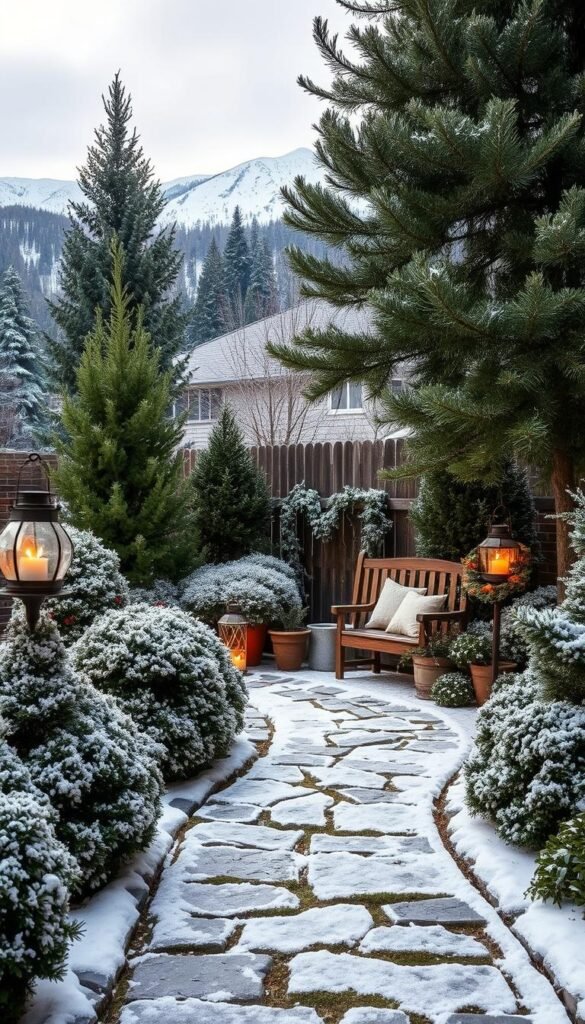Picture stepping into an outdoor space that feels alive even as temperatures drop. Crisp air, twinkling lights, and resilient plants create a scene that’s both peaceful and vibrant. This isn’t just a dream—it’s achievable with thoughtful design and the right choices.
Your cold-weather oasis starts with plants that thrive in chilly conditions. Evergreens, ornamental grasses, and hardy blooms add texture and color when most greenery fades. Pair these with inviting touches like warm blankets, flickering lanterns, or a crackling fire pit to elevate comfort.
Think beyond summer’s bright palette. Soft whites, deep greens, and muted reds shine against frosty backdrops. Add visual drama with sculptural branches or stone accents that catch the light. Even snow becomes part of the charm when framed by intentional design.
What makes these spaces truly special? It’s the blend of natural resilience and human creativity. Strategic layering of heights and materials creates depth, while weather-resistant furnishings ensure year-round use. With smart planning, your outdoor area can become a cherished extension of your home through every season.
Set the Scene: Transforming Your Outdoor Space into a Winter Wonderland
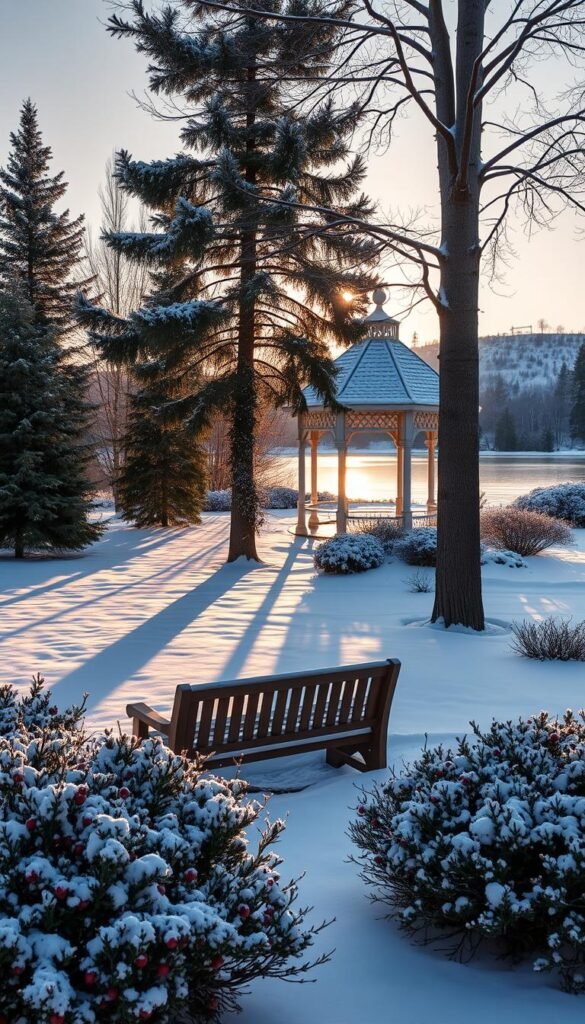
Your backyard becomes a blank canvas when temperatures fall. Start by walking through your property with fresh eyes. Notice how sunlight angles change and where shadows linger. These observations help pinpoint spots for strategic design elements that shine in colder months.
Focus on creating focal points where snow naturally gathers. A sculptural tree or stone bench adds structure when plants sleep. Existing paths gain magic when lined with cold-hardy container plants that peek through light dustings.
Connect indoor and outdoor areas with visual tricks. Position seating areas where house windows frame them perfectly. Use evergreens as living curtains that hide bare spots while filtering wind. Pro tip: Leave some perennials untrimmed—their seed heads catch frost like nature’s jewelry.
Plan for snow’s weight and patterns. Low walls double as snow shelves that highlight your layout. Choose dark mulch to make white accumulations pop. With smart planning, your outdoor space becomes a dynamic showpiece that evolves with each snowfall.
Embrace Evergreen Plants for Lush Winter Color
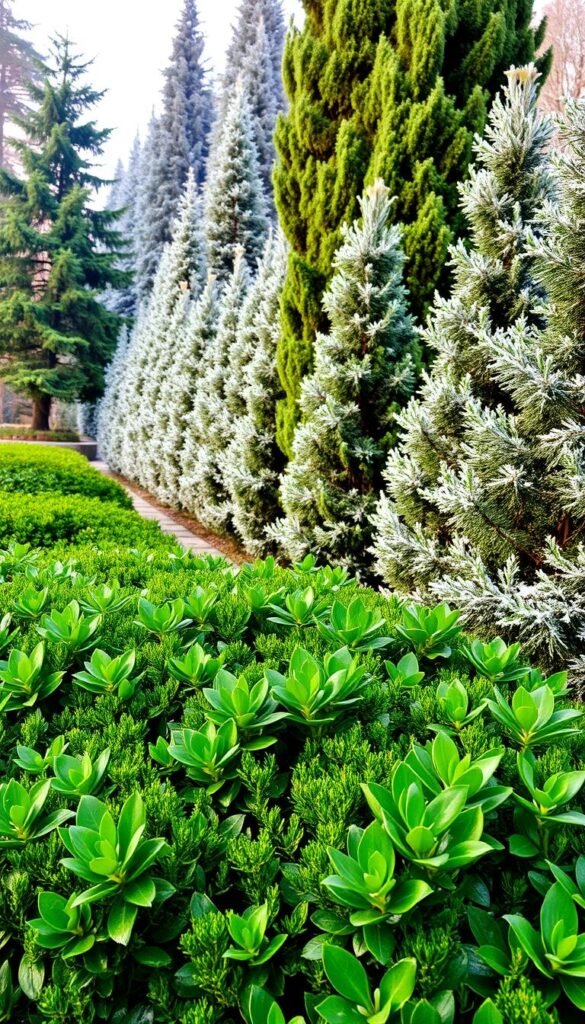
When other plants retreat, evergreens stand tall. These resilient varieties maintain their rich hues through freezing temperatures, offering structure and life to sleeping landscapes. Their secret? Thick waxy leaves and deep roots that resist frost damage while keeping your space vibrant.
Choosing Hardy Varieties Like Boxwood and Pine
Start by matching species to your USDA hardiness zone. Boxwoods thrive in zones 5-8, while white pines handle colder regions down to zone 3. Consider these top performers:
| Plant | Height | Key Feature |
|---|---|---|
| Dwarf Alberta Spruce | 6-8 ft | Compact shape |
| Blue Holly | 15 ft | Berry production |
| Mugo Pine | 5 ft | Drought tolerance |
Using Evergreens as Natural Barriers
Space arborvitae 3-4 feet apart to create living walls that block wind and snow drifts. Layer shorter junipers in front for tiered protection. Design bonus: These green screens make perfect backdrops for whimsical garden designs.
Water deeply before ground freezes to prevent dehydration. Wrap young trees in burlap if temperatures drop below -10°F. Pair with deciduous shrubs for contrasting textures that shine in every season.
Add Vibrancy with Frost-Resistant Flowers and Winter Bedding Plants
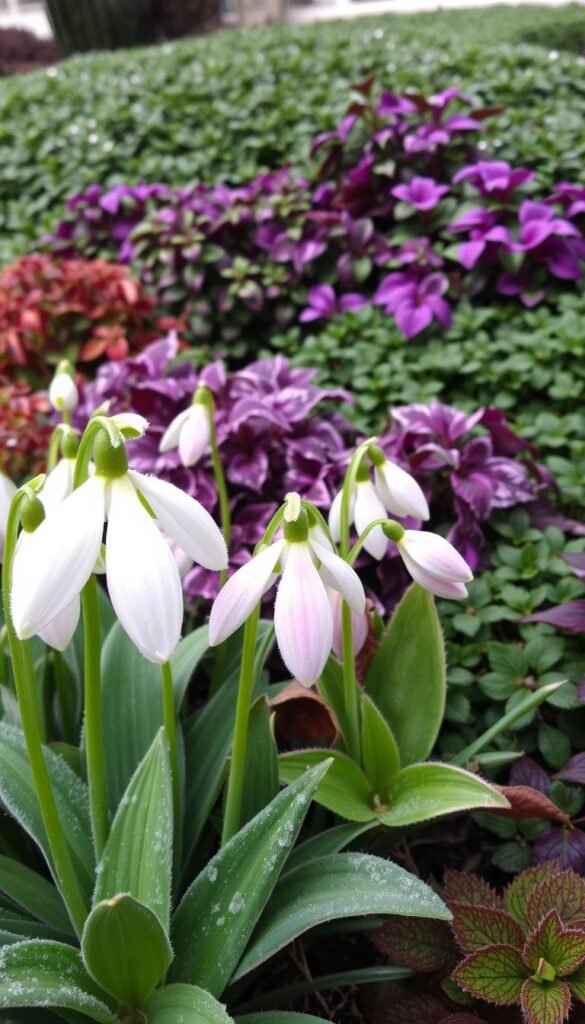
Who says vibrant landscapes belong only to spring? Strategic choices in cold-tolerant blooms can keep your outdoor areas lively even as temperatures plummet. These hardy varieties laugh at frost while delivering pops of jewel-toned hues against muted winter backdrops.
Bright Pansies, Violas, and Ornamental Cabbage
Start with pansies—their cheerful faces bloom through snow in zones 6-9. Violas offer smaller but more abundant flowers, perfect for thriving container displays. Ornamental cabbage steals the show with rosettes that intensify in color as mercury drops.
| Plant | Bloom Period | Care Tips |
|---|---|---|
| Pansies | Oct-Mar | Deadhead weekly |
| Violas | Nov-Feb | Partial sun |
| Ornamental Cabbage | Dec-Apr | Water at soil level |
Plant six weeks before hard frost for established roots. Mix peat moss into soil for drainage—soggy roots spell disaster during freeze-thaw cycles. Pair with silver-leaved greenhouse crops like dusty miller for contrast.
Pro tip: Rotate plantings every 8 weeks. Start violas in late fall, replace with pansies in deep winter, then transition to cabbage as spring approaches. This staggered approach ensures nonstop color through the coldest months.
Create a Cozy Retreat with Fire Pits and Outdoor Heating
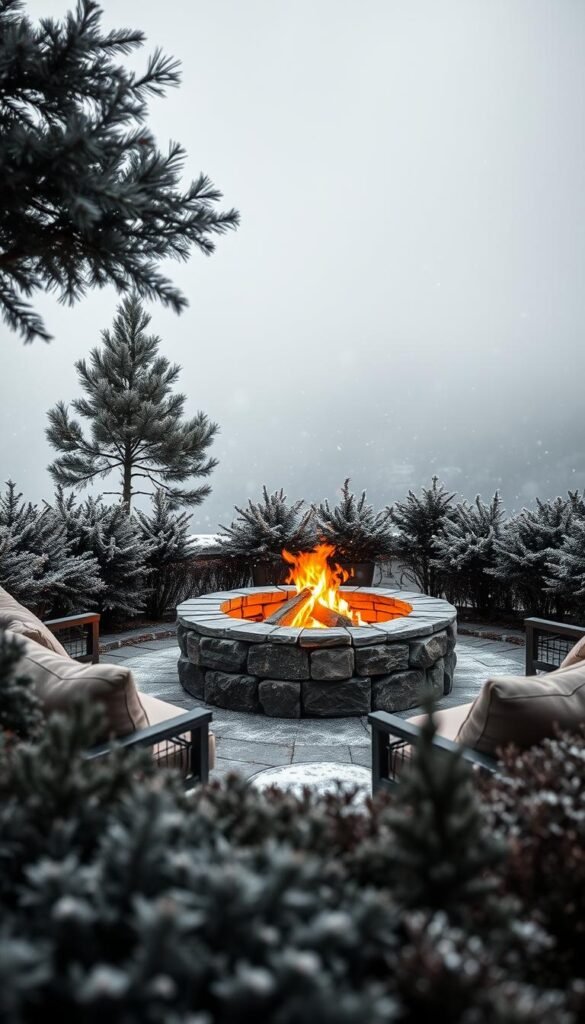
Transform your backyard into a welcoming escape by anchoring it with a glowing fire feature. These elements extend your outdoor space into a four-season retreat where memories are made over crackling flames and shared laughter.
Selecting the Right Materials for Durability
Stone and brick outlast other options, resisting temperature swings without cracking. Steel models work well for modern setups but need galvanized coatings. Always check local codes—some areas require 25-foot clearance from structures.
Arranging Comfortable Seating and Warm Accessories
Circle weatherproof chairs around the flames at 7-10 foot distances for even heat distribution. Add textured throws in wool or fleece that complement your landscape. Propane heaters? Place them under pergolas to trap warmth without smoke.
Quick tip: Use lava rocks in gas fire pits for realistic ember effects. For wood-burning versions, store seasoned logs nearby in a raised rack to prevent moisture damage. Either way, you’ll craft an atmosphere that draws people together like moths to a flame.
Illuminate Your Garden with String Lights and Lanterns
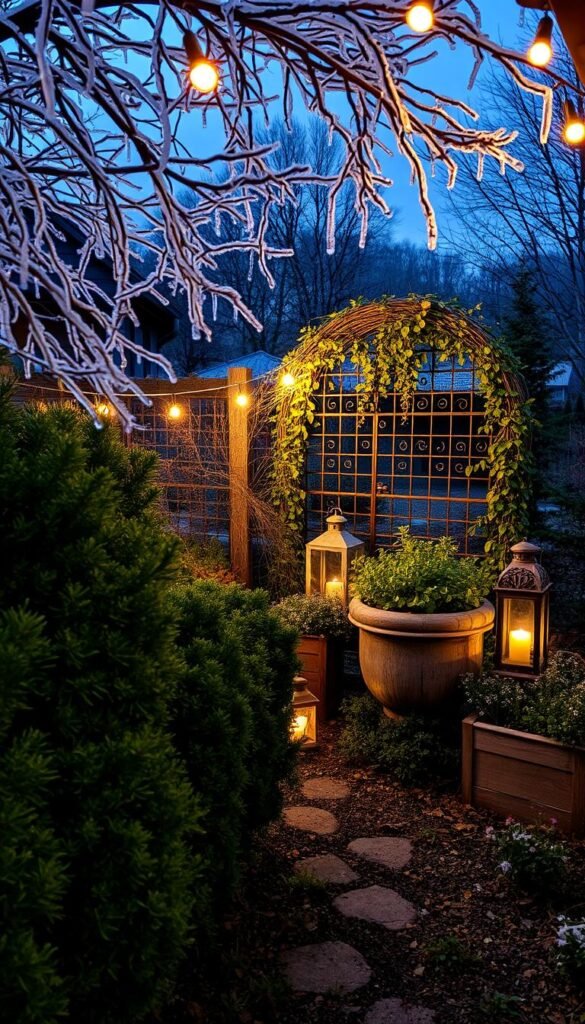
Even in colder months, your outdoor area can glow warmly with carefully placed lights. Draped across bare branches or woven through railings, they turn ordinary spaces into inviting retreats. The right setup balances practicality with charm—weather-resistant materials and smart placement ensure your display shines all season.
Choosing Between Warm White and Festive Colors
Warm white bulbs create a timeless glow that highlights architectural features and plant textures. For a playful twist, multicolored options add energy to holiday gatherings. Consider these factors when deciding:
- Durability: Look for IP65-rated lights designed to withstand snow and ice
- Efficiency: LED strands use 75% less energy than traditional bulbs
- Installation: Use gutter clips for roofs and twist ties for trees to prevent damage
Mix lanterns with string lights for layered illumination. Place solar-powered models along pathways, and hang metal designs near seating areas. Pro tip: Set lights on timers to automatically brighten at dusk—no need to brave the cold to flip switches.
| Light Type | Best For | Ambiance |
|---|---|---|
| Warm White | Year-round elegance | Soft, welcoming |
| Multicolor | Holiday celebrations | Lively, cheerful |
Always check extension cords for outdoor ratings and keep connections elevated above ground moisture. With thoughtful planning, your nights will sparkle as brightly as frost-kissed mornings.
Incorporate Decorative Planters and Garden Statues for Visual Appeal
Elevate your outdoor area’s charm with artful containers and sculptural accents. These design elements maintain structure when blooms fade, creating focal points that draw the eye through snowy landscapes. Choose pieces that reflect your personal style while standing up to harsh weather.
Prioritize durable materials that won’t crack in freeze-thaw cycles. Fiberglass resists chipping, while concrete ages beautifully. Treated wood planters add rustic warmth but need annual sealing. Compare popular options:
| Material | Lifespan | Maintenance |
|---|---|---|
| Fiberglass | 10+ years | Wipe clean |
| Concrete | 20+ years | None |
| Treated Wood | 5-7 years | Reseal yearly |
Cluster planters in odd-numbered groups at varying heights. Place tall urns near entryways and squat bowls along pathways. Pro tip: Add LED string lights inside containers for a magical glow after dusk.
Statues work best when partially framed by nature. Position stone animals peeking through evergreen shrubs or metal abstracts against open snowy areas. Swap seasonal decorations like pinecone garlands in December for red ribbon bows in February—easy updates that refresh your space.
Always elevate pots with feet or gravel layers to prevent ice damage. Drill extra drainage holes and line containers with bubble wrap for root insulation. With smart choices, your arrangements stay vibrant from first frost to spring thaw.
Design a Snowy Pathway for Safe and Stylish Walkways
A well-crafted path transforms your snowy landscape into functional art. Begin by marking a route that connects key areas like entry points or seating zones. Use natural stone or textured pavers to create surfaces that grip boots even when icy.
Prioritize materials that balance safety and style. Flagstone offers rustic charm with natural traction, while brick adds warmth and contrasts beautifully with snow. Compare popular choices:
| Material | Traction | Durability |
|---|---|---|
| Concrete Pavers | High | 15+ years |
| Crushed Granite | Medium | 5-7 years |
| Slate | Excellent | 20+ years |
Slope pathways slightly (1-2%) to direct meltwater away. Bury perforated pipes under gravel bases in areas prone to pooling. Edge with dwarf spruce or boxwood shrubs—their roots stabilize soil while framing the walk.
Embed solar lights every 4-6 feet for glow without wiring. Choose fixtures with motion sensors near steps. Clear snow promptly using plastic shovels to protect surfaces. Smart tip: Sprinkle sand instead of salt to avoid damaging plants or pavers.
Curve paths around specimen trees or decorative boulders to create visual journeys. Add stepping stones through untouched snow patches for playful exploration. Your design becomes both practical guide and artistic statement in frosty months.
Winter Garden Aesthetic: Embracing Frost-Resistant Foliage and Cozy Decor
Imagine a landscape where color persists even under a blanket of snow. Hardy shrubs like holly and viburnum become living sculptures, their branches heavy with berries that glow against muted backgrounds. These natural accents do more than please the eye—they sustain birds when food grows scarce, turning your space into a wildlife sanctuary.
Build visual depth by mixing textures and heights. Pair glossy evergreen leaves with peeling birch bark or feathery grasses. Add pops of crimson from winterberry or golden hues from firethorn. This layered approach keeps your outdoor area dynamic when other yards fade to gray.
| Plant | Berry Color | Height | Wildlife Value |
|---|---|---|---|
| Holly | Red | 15-25 ft | High |
| Winterberry | Bright Red | 6-10 ft | Very High |
| Viburnum | Blue-Black | 8-12 ft | Moderate |
Place specimen plants where snowdrifts naturally gather—near fences or beneath deciduous trees. A lone hawthorn with persistent fruit makes a striking focal point. Design tip: Combine these with cold-hardy edibles like kale for texture variety.
Protect your berry producers with mulch rings and anti-desiccant sprays. Prune selectively in late fall to showcase interesting branch patterns. As days shorten, your thoughtful choices will reveal a scene where beauty and resilience thrive together.
Integrate Festive Touches with Christmas-Themed Arrangements
Your outdoor space transforms into a holiday stage with nature’s own props. Gather materials like evergreen branches and pinecones to craft displays that celebrate the season while blending seamlessly with your landscape. These organic accents bring warmth without overwhelming your existing design.
Harvesting Nature’s Decorations
Start by collecting fresh holly sprigs and flexible branches from your property or local forests. Look for pinecones that haven’t fully opened—they’ll last longer outdoors. Soak materials in water overnight to remove pests before arranging.
Create wreaths using grapevine bases for structure. Weave in holly clusters and pinecones with floral wire, leaving space for tiny lights. Smart tip: Spray arrangements with anti-transpirant to prevent drying from winter winds.
Add pops of color with berry-filled branches or red bows tucked between greens. Place these creations on gates, fences, or empty garden walls to turn your space into a winter wonderland. For extra sparkle, nestle battery-operated lights behind pinecone clusters.
Refresh displays monthly by replacing wilted elements. Store unused materials in breathable bags until needed. With these natural touches, your holiday decorations become part of the landscape rather than just seasonal add-ons.

